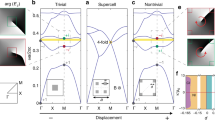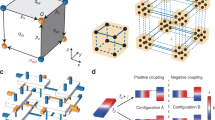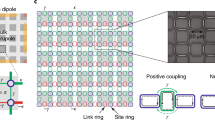Abstract
The modern theory of charge polarization in solids1,2 is based on a generalization of Berry’s phase3. The possibility of the quantization of this phase4,5 arising from parallel transport in momentum space is essential to our understanding of systems with topological band structures6,7,8,9,10. Although based on the concept of charge polarization, this same theory can also be used to characterize the Bloch bands of neutral bosonic systems such as photonic11 or phononic crystals12,13. The theory of this quantized polarization has recently been extended from the dipole moment to higher multipole moments14. In particular, a two-dimensional quantized quadrupole insulator is predicted to have gapped yet topological one-dimensional edge modes, which stabilize zero-dimensional in-gap corner states14. However, such a state of matter has not previously been observed experimentally. Here we report measurements of a phononic quadrupole topological insulator. We experimentally characterize the bulk, edge and corner physics of a mechanical metamaterial (a material with tailored mechanical properties) and find the predicted gapped edge and in-gap corner states. We corroborate our findings by comparing the mechanical properties of a topologically non-trivial system to samples in other phases that are predicted by the quadrupole theory. These topological corner states are an important stepping stone to the experimental realization of topologically protected wave guides12,15 in higher dimensions, and thereby open up a new path for the design of metamaterials16,17.
This is a preview of subscription content, access via your institution
Access options
Access Nature and 54 other Nature Portfolio journals
Get Nature+, our best-value online-access subscription
$29.99 / 30 days
cancel any time
Subscribe to this journal
Receive 51 print issues and online access
$199.00 per year
only $3.90 per issue
Buy this article
- Purchase on Springer Link
- Instant access to full article PDF
Prices may be subject to local taxes which are calculated during checkout




Similar content being viewed by others
References
King-Smith, R. D. & Vanderbilt, D. Theory of polarization of crystalline solids. Phys. Rev. B 47, 1651(R)–1654(R) (1993)
Taherinejad, M., Garrity, K. F. & Vanderbilt, D. Wannier center sheets in topological insulators. Phys. Rev. B 89, 115102 (2014)
Berry, M. V. Quantal phase factors accompanying adiabatic changes. Proc. R. Soc. Lond. A 392, 45–57 (1984)
Thouless, D. J., Kohmoto, M., Nightingale, M. & den Nijs, M. Quantized hall conductance in a two-dimensional periodic potential. Phys. Rev. Lett. 49, 405–408 (1982)
Kane, C. L. & Mele, E. J. Z2 topological order and the quantum spin hall effect. Phys. Rev. Lett. 95, 146802 (2005)
Chiu, C. K., Teo, J. C. Y., Schnyder, A. P. & Ryu, S. Classification of topological quantum matter with symmetries. Rev. Mod. Phys. 88, 035005 (2016)
Klitzing, K. V., Dorda, G. & Pepper, M. New method for high-accuracy determination of the fine-structure constant based on quantized Hall resistance. Phys. Rev. Lett. 45, 494–497 (1980)
König, M. et al. Quantum spin hall insulator state in HgTe quantum wells. Science 318, 766–770 (2007)
Hsieh, D. et al. A topological Dirac insulator in a quantum spin hall phase. Nature 452, 970–974 (2008)
Xu, S.-Y. et al. Discovery of a Weyl fermion semimetal and topological Fermi arcs. Science 349, 613–617 (2015)
Lu, L., Joannopoulos, J. D. & Soljacˇic´, M. Topological states in photonic systems. Nat. Phys. 12, 626–629 (2016)
Süsstrunk, R. & Huber, S. D. Observation of phononic helical edge states in a mechanical topological insulator. Science 349, 47–50 (2015)
Süsstrunk, R. & Huber, S. D. Classification of topological phonons in linear mechanical metamaterials. Proc. Natl Acad. Sci. USA 113, E4767–E4775 (2016)
Benalcazar, W. A., Bernevig, B. A. & Hughes, T. L. Quantized electric multipole insulators. Science 357, 61–66 (2017)
Nash, L. M. et al. Topological mechanics of gyroscopic metamaterials. Proc. Natl Acad. Sci. USA 112, 14495–14500 (2015)
Liu, Z. et al. Locally resonant sonic materials. Science 289, 1734–1736 (2000)
Huber, S. D. Topological mechanics. Nat. Phys. 12, 621–623 (2016)
Bernevig, B. A., Hughes, T. L. & Zhang, S.-C. Quantum spin Hall effect and topological phase transition in HgTe quantum wells. Science 314, 1757–1761 (2006)
Fu, L. & Kane, C. L. Time reversal polarization and a Z2 adiabatic spin pump. Phys. Rev. B 74, 195312 (2006)
Moore, J. E. & Balents, L. Topological invariants of time-reversal-invariant band structures. Phys. Rev. B 75, 121306(R) (2007)
Qi, X.-L., Hughes, T. L. & Zhang, S.-C. Topological field theory of time-reversal invariant insulators. Phys. Rev. B 78, 195424 (2008)
Xiao, M. et al. Geometric phase and band inversion in periodic acoustic systems. Nat. Phys. 11, 240–244 (2015)
Rechtsman, M. C. et al. Photonic Floquet topological insulators. Nature 496, 196–200 (2013)
Hafezi, M., Mittal, S., Fan, J., Migdall, A. & Taylor, J. M. Imaging topological edge states in silicon photonics. Nat. Photon. 7, 1001–1005 (2013)
Lang, N. & Büchler, H. P. Topological networks for quantum communication between distant qubits. Quantum Inf. 3, 47 (2017)
Benalcazar, W. A., Bernevig, B. A. & Hughes, T. L. Electric multipole moments, topological multipole moment pumping, and chiral hinge states in crystalline insulators. Phys. Rev. B 96, 245115 (2017)
Fidkowski, L., Jackson, T. S. & Klich, I. Model characterization of gapless edge modes of topological insulators using intermediate Brillouin-zone functions. Phys. Rev. Lett. 107, 036601 (2011)
Matlack, K. H ., Serra-Garcia, M ., Palermo, A ., Huber, S. D . & Daraio, C. Designing perturbative metamaterials from discrete models. Nat. Mater. https://doi.org/10.1038/s41563-017-0003-3 (2018)
Coulais, C., Teomy, E., de Reus, K., Shokef, Y. & van Hecke, M. Combinatorial design of textured mechanical metamaterials. Nature 535, 529–532 (2016)
Imhof, S. et al. Topoelectrical circuit realization of topological corner modes. Preprint at https://arxiv.org/abs/1708.03647 (2017)
Peterson, C. W., Benalcazar, W. A., Hughes, T. L. & Bahl, G. Demonstration of a quantized microwave quadrupole insulator with topologically protected corner states. Preprint at https://arxiv.org/abs/1710.03231 (2017)
Su, W. P., Schrieffer, J. R. & Heeger, A. J. Solitons in polyacetylene. Phys. Rev. Lett. 42, 1698–1701 (1979)
Hall, J. J. Electronic effects in the elastic constants of n-type silicon. Phys. Rev. 161, 756–761 (1967)
Acknowledgements
We acknowledge financial support from the Swiss National Science Foundation and the NCCR QSIT. T.L. acknowledges support from a Marie Curie fellowship and O.R.B. from the ETH postdoctoral fellowship FEL-26 15-2.
Author information
Authors and Affiliations
Contributions
S.D.H. conceived the research. M.S.-G., V.P. and O.R.B. designed the samples. M.S.-G., V.P., S.D.H. and R.S. conducted the experiments. L.G.V. and T.L. fabricated the samples.
Corresponding author
Ethics declarations
Competing interests
The authors declare no competing financial interests.
Additional information
Publisher's note: Springer Nature remains neutral with regard to jurisdictional claims in published maps and institutional affiliations.
Extended data figures and tables
Extended Data Figure 1 Phase diagram.
a, Phase diagram of the model in equation (3). The brown area marks the quantized quadrupole phase (1/2, 1/2), whereas the orange areas are the (1/2, 0) and (0, 1/2) phases with no corner modes but emergent edge physics along two parallel edges. The dashed line indicates the C4-symmetric line, where the bulk gap is closing at the phase transition. The transitions away from the C4-symmetric line happen through bulk-induced edge transitions, where no bulk gap is closing. b, The evolution of the Wannier bands in the x and y directions along the path shown in a. The transition from the quadrupole phase to the (1/2, 0) phase is marked by a gap closing at 1/2, removing any polarization in the system. The second transition is induced by a gap closing at 0.
Extended Data Figure 2 Transducer characterization.
The sound pressure level (SPL) in the frequency response of the ultrasound transducer that we used over the frequency region of interest (shaded in grey). The 0.46 dB fluctuations are negligible with respect to the 80 dB variations in the measured response.
Extended Data Figure 3 Corner Greens functions.
a–d, The corner plates at (0, 9) (a), (9, 9) (b), (0, 0) (c) and (9, 0) (d) are excited at the respective edge-mode frequency. The response recorded (amplitude and phase) enables us to reconstruct the eigenfunctions ψ(x, y) of the individual corner modes. Along each edge, the measured decay of the modes (black) is shown together with the theoretical prediction (orange). Given the decay length ξ/a ≈ 1.6, where a is the lattice constant, the residual weight of at most 2% at the corners other than the one that is excited stems from spurious acoustic excitation rather than hybridization.
Extended Data Figure 4 Edge Greens function.
a, Sketch of the measured system. The bottom-left plate at (x, y) = (0, 0) was excited. b, Integrated frequency response  , where i runs along the red and black edges indicted by the solid lines in a. The two highest-frequency peaks below the bandgap (indicated by vertical lines) are analysed. c, The decay of the two edge modes into the bulk (black) along the dashed lines in a. The orange lines show the theoretical predictions. d, The mode profiles ψ(x, y) along the two edges. The edge with positive couplings has nodes between the unit cells (top panel, black), whereas the edge with negative couplings has nodes inside the unit cell (bottom panel, red), which establishes that a direct measurement of the negative couplings gives rise to the π flux.
, where i runs along the red and black edges indicted by the solid lines in a. The two highest-frequency peaks below the bandgap (indicated by vertical lines) are analysed. c, The decay of the two edge modes into the bulk (black) along the dashed lines in a. The orange lines show the theoretical predictions. d, The mode profiles ψ(x, y) along the two edges. The edge with positive couplings has nodes between the unit cells (top panel, black), whereas the edge with negative couplings has nodes inside the unit cell (bottom panel, red), which establishes that a direct measurement of the negative couplings gives rise to the π flux.
Extended Data Figure 5 Perturbative design of a quadrupole topological insulator.
a, The design approach is based on establishing a correspondence between elements of an objective model (left) and geometric features of the metamaterial (right). Each degree of freedom of the objective model is mapped into a single plate (yellow arrows) by expressing the displacement of each plate as a linear combination of free-plate modes. b, Here, only the first non-rigid-body mode, which has dxy symmetry, is used (top left). The other modes are the second, third and fourth non-rigid-body modes. c, Independent two-plate systems simulated to create an adequate initial guess for the geometry of the system. d, Four-unit-cell design simulated during the final gradient optimization. e, The refined single-plate design removes material at the maximums of nearby higher-order modes. f, Small trenches at the junction between beams and plates. These trenches suppress the coupling to higher-order modes by avoiding regions where these modes have a large displacement. g, Dispersion along high-symmetry lines in the Brillouin zone calculated using the finite-element method. The bands that arise from the dxy mode are highlighted in colour. h, Detailed view of the spectrum in the frequency range of interest. The dots denote the full finite-element results whereas the lines are calculated from the extracted reduced-order model.
Rights and permissions
About this article
Cite this article
Serra-Garcia, M., Peri, V., Süsstrunk, R. et al. Observation of a phononic quadrupole topological insulator. Nature 555, 342–345 (2018). https://doi.org/10.1038/nature25156
Received:
Accepted:
Published:
Issue Date:
DOI: https://doi.org/10.1038/nature25156
This article is cited by
-
Programmable integrated photonics for topological Hamiltonians
Nature Communications (2024)
-
Discrete nonlinear topological photonics
Nature Physics (2024)
-
The higher-order topological pumping explored in the 2D acoustic crystal
Science China Physics, Mechanics & Astronomy (2024)
-
Realization of photonic p-orbital higher-order topological insulators
eLight (2023)
-
Acoustic realization of projective mirror Chern insulators
Communications Physics (2023)
Comments
By submitting a comment you agree to abide by our Terms and Community Guidelines. If you find something abusive or that does not comply with our terms or guidelines please flag it as inappropriate.



